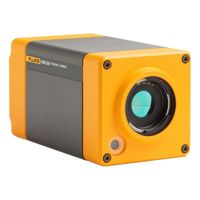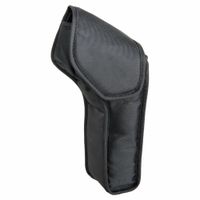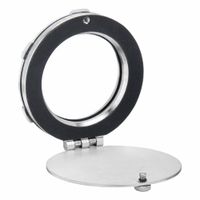Call +(254) 703 030 000 / 751 483 999 / 721 704 777
- Home
- Test Instruments
- Temperature And Environmental Measurement
- Infrared Temperature Measurement
- Infrared Cameras Accessories
.....Read More
Frequently Asked Questions
What is an infrared camera and how does it work?
An infrared camera, also known as a thermal imaging camera, detects infrared radiation (heat) emitted by objects and converts it into an electronic signal to produce a thermal image. Unlike visible light cameras, infrared cameras can capture images in complete darkness and through smoke, fog, or other obscurants.
Infrared cameras operate based on the principle that all objects emit infrared radiation as a function of their temperature. The camera's sensor, typically made of materials like indium antimonide (InSb) or vanadium oxide (VOx), detects this radiation. The sensor is sensitive to wavelengths in the infrared spectrum, usually between 3 to 14 micrometers.
The camera's lens focuses the infrared radiation onto the sensor, which then converts the radiation into an electrical signal. This signal is processed to create a visual representation, known as a thermogram, where different temperatures are represented by varying colors or shades of gray. Warmer areas appear in colors like red, orange, or yellow, while cooler areas appear in blue or purple.
Infrared cameras are used in various applications, including building inspections, electrical maintenance, medical diagnostics, and military operations. They help identify heat leaks, electrical faults, inflammation in the human body, and hidden objects or people in low-visibility conditions.
Some advanced infrared cameras also feature image fusion, combining thermal images with visible light images for enhanced detail and context. They may include features like adjustable emissivity settings, temperature measurement tools, and connectivity options for data transfer and analysis.
How do I choose the right infrared camera for my needs?
1. **Purpose and Application**: Determine the primary use (e.g., electrical inspections, building diagnostics, industrial maintenance, or research) to narrow down features and specifications.
2. **Resolution**: Choose a camera with adequate resolution. Higher resolution provides more detail, which is crucial for accurate analysis. Common resolutions range from 80x60 to 640x480 pixels.
3. **Temperature Range**: Ensure the camera can measure the temperature range required for your application. Industrial applications may need a broader range than building inspections.
4. **Sensitivity (NETD)**: Look for a camera with a low Noise Equivalent Temperature Difference (NETD) for better sensitivity and the ability to detect small temperature differences.
5. **Lens Options**: Consider cameras with interchangeable lenses if you need flexibility in field of view or focus distance.
6. **Focus Mechanism**: Decide between manual, fixed, or auto-focus based on the level of detail required and ease of use.
7. **Image and Video Capture**: Check if the camera supports still images, video recording, and real-time streaming if needed for documentation or analysis.
8. **Display and Interface**: A large, high-resolution display and intuitive interface can enhance usability. Touchscreen options may offer easier navigation.
9. **Software and Connectivity**: Ensure compatibility with analysis software and check for connectivity options like Wi-Fi, Bluetooth, or USB for data transfer.
10. **Durability and Ergonomics**: Consider the camera's build quality, weight, and design for comfort during prolonged use, especially in harsh environments.
11. **Budget**: Balance features with cost. Higher-end models offer advanced features but may exceed budget constraints.
12. **Brand and Support**: Opt for reputable brands with good customer support and warranty options for reliability and service.
What are the applications of infrared cameras?
Infrared cameras, also known as thermal imaging cameras, have a wide range of applications across various fields due to their ability to detect heat and visualize temperature differences.
1. **Surveillance and Security**: Infrared cameras are used in security systems to detect intruders in low-light or no-light conditions. They can identify heat signatures, making them effective for night surveillance.
2. **Search and Rescue**: In emergency situations, infrared cameras help locate people in darkness, smoke, or dense foliage by detecting body heat, aiding in faster rescues.
3. **Building Inspections**: They are used to identify heat leaks, moisture intrusion, and electrical faults in buildings, helping in energy audits and maintenance.
4. **Medical Diagnostics**: Infrared imaging is used in medicine to detect abnormal heat patterns in the body, which can indicate inflammation, poor circulation, or tumors.
5. **Industrial Maintenance**: In industries, infrared cameras are used for predictive maintenance by identifying overheating components in machinery, preventing failures and downtime.
6. **Environmental Monitoring**: They help in monitoring wildlife, studying animal behavior, and detecting environmental changes like forest fires by capturing heat patterns.
7. **Automotive**: In vehicles, infrared cameras are used for night vision systems to enhance driver visibility and safety in low-light conditions.
8. **Research and Development**: Infrared cameras are used in scientific research to study thermal properties and behaviors in various materials and processes.
9. **Agriculture**: They assist in monitoring crop health, detecting water stress, and managing irrigation by visualizing temperature variations in fields.
10. **Law Enforcement**: Used in tactical operations to track suspects and in forensic investigations to detect evidence not visible to the naked eye.
These applications demonstrate the versatility and importance of infrared cameras in enhancing safety, efficiency, and understanding across multiple domains.
How accurate are infrared cameras in measuring temperature?
Infrared cameras, also known as thermal cameras, measure temperature by detecting infrared radiation emitted by objects. Their accuracy depends on several factors:
1. **Emissivity**: This is the efficiency with which an object emits infrared radiation. Most infrared cameras allow users to adjust emissivity settings to match the material being measured. Incorrect settings can lead to inaccurate readings.
2. **Calibration**: Regular calibration against known temperature standards is crucial for maintaining accuracy. Without calibration, the camera's readings can drift over time.
3. **Environmental Conditions**: Factors such as ambient temperature, humidity, and atmospheric conditions can affect accuracy. For instance, high humidity can absorb infrared radiation, leading to lower readings.
4. **Distance and Field of View**: The distance between the camera and the object, as well as the camera's field of view, can impact accuracy. Greater distances can reduce resolution and accuracy, while a wide field of view might include unwanted objects that affect the reading.
5. **Camera Resolution**: Higher resolution cameras provide more detailed images and can measure temperature more accurately across small areas.
6. **Temperature Range**: Cameras have specific temperature ranges they can measure accurately. Operating outside these ranges can lead to errors.
7. **Lens Quality**: The quality and type of lens can affect the focus and clarity of the thermal image, impacting accuracy.
In optimal conditions, high-quality infrared cameras can achieve accuracy within ±2°C or ±2% of the reading, whichever is greater. However, in less controlled environments, accuracy can decrease. Proper training and understanding of the camera's limitations are essential for obtaining reliable temperature measurements.
Can infrared cameras see through walls or other solid objects?
No, infrared cameras cannot see through walls or other solid objects. Infrared cameras detect infrared radiation, which is emitted by objects as heat. Walls and solid objects block this radiation, preventing the camera from capturing any thermal information from the other side. Instead, infrared cameras can only detect the surface temperature of the wall itself. While they can be used to identify heat patterns on the surface, such as areas of heat loss or insulation issues, they cannot provide images or information about what is behind or inside the wall.
What are the benefits of using infrared cameras for inspections?
Infrared cameras offer several benefits for inspections:
1. **Non-Destructive Testing**: They allow for the inspection of equipment and structures without causing any damage, making them ideal for routine maintenance checks.
2. **Early Problem Detection**: Infrared cameras can detect heat patterns and anomalies that indicate potential issues, such as electrical faults, mechanical failures, or insulation deficiencies, before they lead to significant problems.
3. **Increased Safety**: By identifying hot spots and overheating components, infrared cameras help prevent accidents and equipment failures, enhancing workplace safety.
4. **Efficiency and Speed**: Inspections can be conducted quickly and efficiently, covering large areas in a short time without the need for physical contact or disassembly.
5. **Cost Savings**: Early detection of issues can prevent costly repairs and downtime, leading to significant cost savings over time.
6. **Versatility**: Infrared cameras can be used in various industries, including electrical, mechanical, building, and manufacturing, making them a versatile tool for different inspection needs.
7. **Data Documentation**: They provide visual documentation of thermal patterns, which can be used for analysis, reporting, and record-keeping, aiding in trend analysis and decision-making.
8. **Remote Monitoring**: Infrared cameras can be used for remote monitoring of equipment and systems, allowing for continuous surveillance and immediate response to any detected anomalies.
9. **Environmental Adaptability**: They can operate in various environmental conditions, including low light and adverse weather, ensuring reliable inspections in challenging settings.
10. **Energy Efficiency**: By identifying areas of energy loss, such as poor insulation or air leaks, infrared cameras help improve energy efficiency in buildings and industrial processes.
How do I maintain and care for my infrared camera and its accessories?
1. **Regular Cleaning**: Use a soft, lint-free cloth to clean the camera lens and body. Avoid using harsh chemicals; instead, use lens cleaning solutions or wipes specifically designed for optics.
2. **Proper Storage**: Store the camera in a protective case when not in use. Ensure the storage area is dry and free from dust. Use silica gel packs to control humidity and prevent moisture buildup.
3. **Battery Care**: Charge the battery fully before use and avoid letting it completely discharge. Remove the battery if the camera will not be used for an extended period. Store batteries in a cool, dry place.
4. **Lens Protection**: Use lens caps when the camera is not in use to protect the lens from scratches and dust. Consider using a UV filter for additional protection.
5. **Firmware Updates**: Regularly check for and install firmware updates from the manufacturer to ensure optimal performance and access to new features.
6. **Calibration**: Periodically calibrate the camera according to the manufacturer’s instructions to maintain accuracy in temperature readings.
7. **Environmental Considerations**: Avoid exposing the camera to extreme temperatures, direct sunlight, or moisture. Use weatherproof covers if operating in harsh conditions.
8. **Accessory Maintenance**: Clean and inspect accessories like tripods, cables, and mounts regularly. Ensure all connections are secure and free from corrosion.
9. **Professional Servicing**: Schedule regular professional maintenance checks, especially if the camera is used frequently or in demanding environments.
10. **User Manual**: Refer to the user manual for specific maintenance guidelines and troubleshooting tips provided by the manufacturer.
11. **Handling**: Handle the camera with care, avoiding drops or impacts. Use a neck or wrist strap to prevent accidental falls.
12. **Software Management**: Keep any associated software updated and back up important data regularly.




